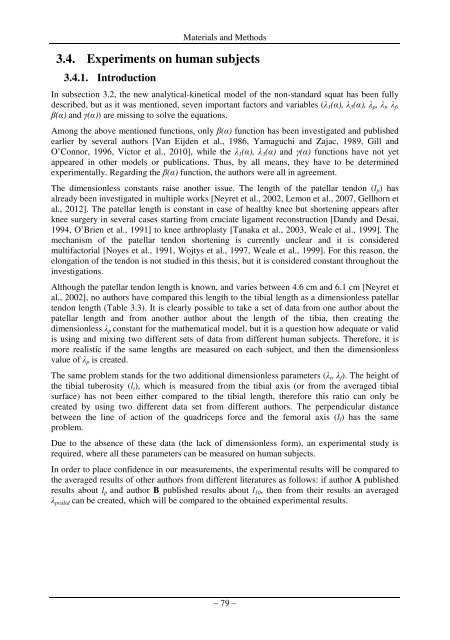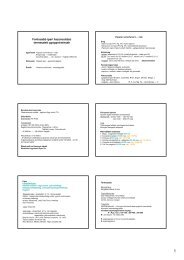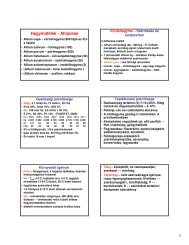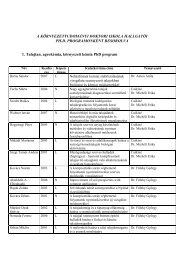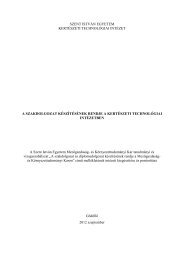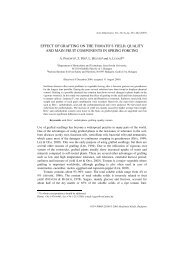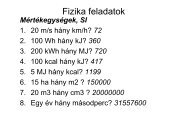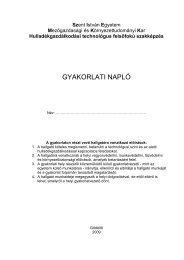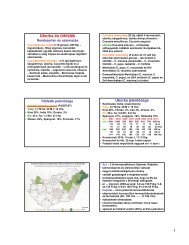PhD Fekete - SZIE version - 2.2 - Szent István Egyetem
PhD Fekete - SZIE version - 2.2 - Szent István Egyetem
PhD Fekete - SZIE version - 2.2 - Szent István Egyetem
Create successful ePaper yourself
Turn your PDF publications into a flip-book with our unique Google optimized e-Paper software.
Materials and Methods<br />
3.4. Experiments on human subjects<br />
3.4.1. Introduction<br />
In subsection 3.2, the new analytical-kinetical model of the non-standard squat has been fully<br />
described, but as it was mentioned, seven important factors and variables (λ 1 (α), λ 3 (α), λ p , λ t , λ f ,<br />
β(α) and γ(α)) are missing to solve the equations.<br />
Among the above mentioned functions, only β(α) function has been investigated and published<br />
earlier by several authors [Van Eijden et al., 1986, Yamaguchi and Zajac, 1989, Gill and<br />
O’Connor, 1996, Victor et al., 2010], while the λ 1 (α), λ 3 (α) and γ(α) functions have not yet<br />
appeared in other models or publications. Thus, by all means, they have to be determined<br />
experimentally. Regarding the β(α) function, the authors were all in agreement.<br />
The dimensionless constants raise another issue. The length of the patellar tendon (l p ) has<br />
already been investigated in multiple works [Neyret et al., 2002, Lemon et al., 2007, Gellhorn et<br />
al., 2012]. The patellar length is constant in case of healthy knee but shortening appears after<br />
knee surgery in several cases starting from cruciate ligament reconstruction [Dandy and Desai,<br />
1994, O’Brien et al., 1991] to knee arthroplasty [Tanaka et al., 2003, Weale et al., 1999]. The<br />
mechanism of the patellar tendon shortening is currently unclear and it is considered<br />
multifactorial [Noyes et al., 1991, Wojtys et al., 1997, Weale et al., 1999]. For this reason, the<br />
elongation of the tendon is not studied in this thesis, but it is considered constant throughout the<br />
investigations.<br />
Although the patellar tendon length is known, and varies between 4.6 cm and 6.1 cm [Neyret et<br />
al., 2002], no authors have compared this length to the tibial length as a dimensionless patellar<br />
tendon length (Table 3.3). It is clearly possible to take a set of data from one author about the<br />
patellar length and from another author about the length of the tibia, then creating the<br />
dimensionless λ p constant for the mathematical model, but it is a question how adequate or valid<br />
is using and mixing two different sets of data from different human subjects. Therefore, it is<br />
more realistic if the same lengths are measured on each subject, and then the dimensionless<br />
value of λ p is created.<br />
The same problem stands for the two additional dimensionless parameters (λ t , λ f ). The height of<br />
the tibial tuberosity (l t ), which is measured from the tibial axis (or from the averaged tibial<br />
surface) has not been either compared to the tibial length, therefore this ratio can only be<br />
created by using two different data set from different authors. The perpendicular distance<br />
between the line of action of the quadriceps force and the femoral axis (l f ) has the same<br />
problem.<br />
Due to the absence of these data (the lack of dimensionless form), an experimental study is<br />
required, where all these parameters can be measured on human subjects.<br />
In order to place confidence in our measurements, the experimental results will be compared to<br />
the averaged results of other authors from different literatures as follows: if author A published<br />
results about l p and author B published results about l 10 , then from their results an averaged<br />
λ pvalid can be created, which will be compared to the obtained experimental results.<br />
– 79 –


